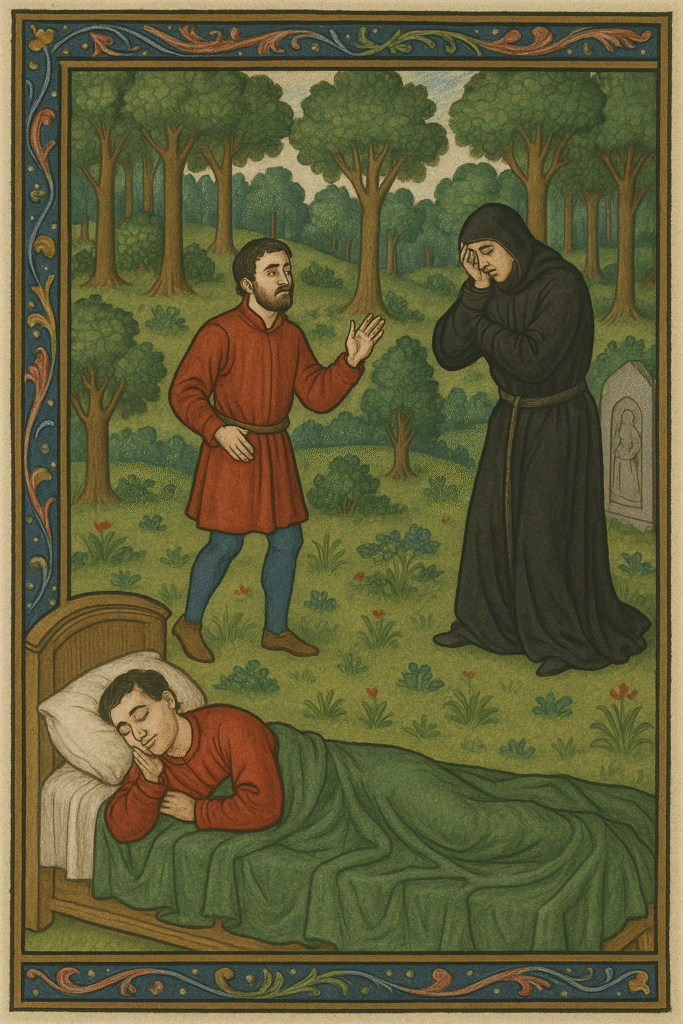Introduction: Power of Dream Vision in The Book of the Duchess
The dream vision in The Book of the Duchess is a brilliant narrative device used by Geoffrey Chaucer to explore deep emotional experiences. This medieval poem skillfully blends reality with symbolism through a dream framework. By using the dream vision in The Book of the Duchess, Chaucer not only introduces his audience to a poetic tradition but also conveys complex themes like grief, memory, and healing in an imaginative way. This technique provides structure, depth, and symbolic meaning, making the poem both artistic and emotionally impactful.

Origins and Purpose of Dream Vision in The Book of the Duchess
Understanding the dream vision begins with recognizing its roots in classical and medieval literature. Inspired by writers like Boethius and French dream poets, Chaucer adapts the form to his own purpose. The dream vision in The Book of the Duchess allows him to portray personal loss in an allegorical, indirect manner. Moreover, it helps the narrator (and the reader) gradually process emotions through the symbolic journey of the dream. As a result, the dream vision serves as both a literary tool and an emotional outlet.
Structure of Dream Vision
The structure of the dream vision follows a clear and purposeful pattern. It starts with the narrator’s insomnia and emotional distress. He reads a book, falls asleep, and enters a dream world. In that dream, he meets various characters and ultimately encounters a mourning knight. This layered storytelling allows Chaucer to maintain distance from the raw emotion while still expressing it vividly. The dream vision functions as a frame that organizes the narrative and gives it emotional momentum.
Symbolism in the Dream Vision
Symbolism plays a central role in the dream vision . The hunting scene, the white hall, and the game of chess mentioned by the knight all serve as symbolic devices. Each element in the dream carries deeper meaning. For example, the game of chess represents the loss of Blanche, while the color white reflects purity and mourning. Through this symbolism, the dream vision transforms real grief into poetic expression. Readers must interpret the dream symbols to uncover the poem’s emotional core.
Emotional Distance in the Dream Vision
One key benefit of using the dream vision is that it creates emotional distance. The narrator is not Chaucer directly, and the knight is not explicitly named as John of Gaunt. This indirect storytelling allows Chaucer to write about a painful real-life event—the death of Blanche of Lancaster—without overwhelming the audience. Through the dream vision , the pain is expressed subtly but with sincerity. This approach makes the poem powerful and accessible to readers of different emotional states.
Dialogue as Revelation in the Dream Vision in The Book of the Duchess**
The central dialogue between the narrator and the black-clad knight is the emotional heart of the dream vision . Initially, the knight speaks in riddles and avoids revealing his sorrow. However, as the dialogue progresses, he opens up, sharing his grief over the loss of his lady. This slow unfolding of truth mirrors the way people cope with trauma in real life. Chaucer’s use of the dream vision helps to dramatize the emotional healing process through conversation.
Framing and Poetic Control in the Dream Vision in The Book of the Duchess
Framing gives Chaucer total artistic control in the dream vision . The dream allows him to craft scenes of beauty, mystery, and emotional depth. He decides when the dream begins, how it flows, and where it ends. This control enhances the poem’s pacing and structure. The dream vision frames the story perfectly, guiding the reader from confusion to clarity. It also allows the poet to integrate personal elements without making them appear overly direct or intrusive.
The Dream Vision in The Book of the Duchess as Emotional Therapy
Chaucer also uses the dream vision as a form of emotional therapy—for both the narrator and the audience. The narrator’s sleeplessness suggests an internal struggle. After experiencing the dream, he awakens with greater understanding. This reflects the idea that dreams help people work through emotions. The dream vision serves this exact role, offering comfort through imaginative storytelling. It helps externalize grief, making it easier to examine and accept.
The Visual Aesthetics of Dream Vision in The Book of the Duchess
Visual elements are rich and vivid in the dream vision . The imagery of the dream—green forests, white halls, noble hunts, and pale figures—adds sensory depth to the emotional journey. These visuals help the reader feel immersed in the dream. The dream vision blends visual beauty with emotional weight, making the experience more memorable and meaningful. Chaucer creates a world that is not only symbolic but also artistically stunning.
Conclusion: Lasting Impact of Dream Vision in The Book of the Duchess
In conclusion, the dream vision in The Book of the Duchess stands as a masterful narrative technique. It offers structure, symbolism, emotional distance, and poetic freedom. Chaucer uses this device to turn a personal and historical tragedy into an elegant literary experience. From framing and dialogue to imagery and emotion, every part of the dream vision contributes to its impact. This technique continues to inspire readers and scholars, proving its timeless relevance in English literature.
Characterization of the Duchess: https://englishlitnotes.com/2025/05/07/allegory-and-symbolism-in-the-book-of-the-duchess/
English Notes for All Classes: https://englishwithnaeemullahbutt.com/
Discover more from Naeem Ullah Butt - Mr.Blogger
Subscribe to get the latest posts sent to your email.
